
The Hollywood Revue of 1929, or simply The Hollywood Revue, is a 1929 American pre-Code musical comedy film released by Metro-Goldwyn-Mayer. It was the studio's second feature-length musical, and one of their earliest sound films. Produced by Harry Rapf and Irving Thalberg and directed by Charles Reisner, it features nearly all of MGM's stars in a two-hour revue that includes three segments in Technicolor. The masters of ceremonies are Conrad Nagel and Jack Benny.
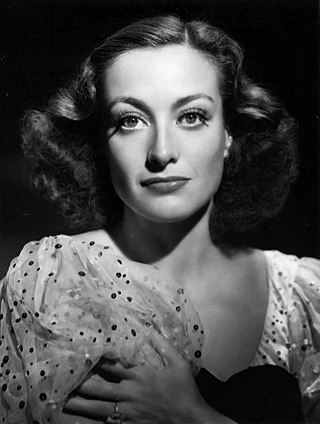
Joan Crawford was an American actress. She started her career as a dancer in traveling theatrical companies before debuting on Broadway. Crawford was signed to a motion picture contract by Metro-Goldwyn-Mayer in 1925. Initially frustrated by the size and quality of her parts, Crawford launched a publicity campaign and built an image as a nationally known flapper by the end of the 1920s. By the 1930s, Crawford's fame rivaled MGM colleagues Norma Shearer and Greta Garbo. Crawford often played hardworking young women who find romance and financial success. These "rags-to-riches" stories were well received by Depression-era audiences and were popular with women. Crawford became one of Hollywood's most prominent movie stars and one of the highest paid women in the United States, but her films began losing money. By the end of the 1930s, she was labeled "box office poison".

John Gilbert was an American actor, screenwriter and director. He rose to fame during the silent era and became a popular leading man known as "The Great Lover". His breakthrough came in 1925 with his starring roles in The Merry Widow and The Big Parade. At the height of his career, Gilbert rivaled Rudolph Valentino as a box office draw.

Carmel Myers was an American actress who achieved her greatest successes in silent film.

Winners of the Wilderness is a 1927 American silent war drama film directed by W.S. Van Dyke and starring Tim McCoy and Joan Crawford. In this costume drama, set during the French and Indian War (1754-1763), Rene Contrecouer (Crawford), the daughter of a French general falls for a soldier of fortune (McCoy). The film was photographed mostly in black and white, but one scene was in color by Technicolor.

The Understanding Heart is a 1927 American silent adventure drama film directed by Jack Conway and stars Joan Crawford in an early leading role. The film was adapted for the screen by Edward T. Lowe Jr. from the novel of the same name by Peter B. Kyne.

Twelve Miles Out is a 1927 American silent drama film directed by Jack Conway and starring John Gilbert and Joan Crawford. It is based on the 1925 Broadway play Twelve Miles Out by William Anthony McGuire.

Dream of Love is a 1928 American synchronized sound biographical drama film directed by Fred Niblo, and starring Joan Crawford and Nils Asther. While the film has no audible dialog, it was released with a synchronized musical score with sound effects using both the sound-on-disc and sound-on-film process. The sound was recorded via the Western Electric sound system. The film is based on the 1849 French tragedy Adrienne Lecouvreur by Eugène Scribe and Ernest Legouvé.
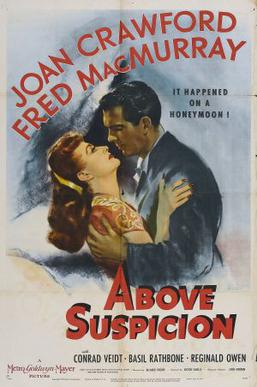
Above Suspicion is a 1943 American spy film directed by Richard Thorpe and starring Joan Crawford and Fred MacMurray. The screenplay was adapted from the 1941 novel Above Suspicion by Scots-American writer Helen MacInnes, which is loosely based on the experiences of MacInnes and her husband Gilbert Highet.

The Only Thing is a 1925 American silent romantic drama film starring Eleanor Boardman. The film's scenario was written by author Elinor Glyn, and was based on a story adapted from Glyn's novel of the same name.
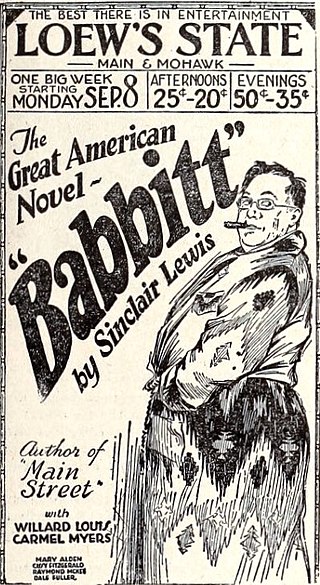
Babbitt is a 1924 American silent drama film directed by Harry Beaumont and starring Willard Louis, Mary Alden, and Carmel Myers. It is based on the 1922 novel of the same title by Sinclair Lewis, later also adapted into a 1934 sound film.

Two for Tonight is a 1935 American musical comedy film directed by Frank Tuttle and starring Bing Crosby, Joan Bennett, and Mary Boland. Based on the play Two for Tonight by J. O. Lief and Max Lief, the film is about a songwriter who composes a full-length theatrical piece within a few days.
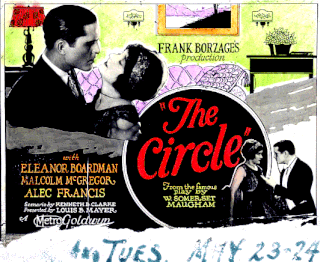
The Circle is a 1925 American silent romantic comedy film directed by Frank Borzage. The film stars Eleanor Boardman, Malcolm McGregor, and Alec B. Francis. A young Joan Crawford appears in the film's opening scene and later in a photograph viewed by other characters. The screenplay, written by Kenneth B. Clarke, was based on the 1921 play of the same title by W. Somerset Maugham.

The Gay Deceiver is a 1926 American silent romantic drama film directed by John M. Stahl. The film stars Lew Cody and Carmel Myers.

A Certain Young Man is a 1928 comedy film directed by Hobart Henley. The film stars Ramon Novarro, Marceline Day, Renée Adorée, Carmel Myers and Bert Roach. The film is considered lost. A trailer for the film is preserved at the Library of Congress.
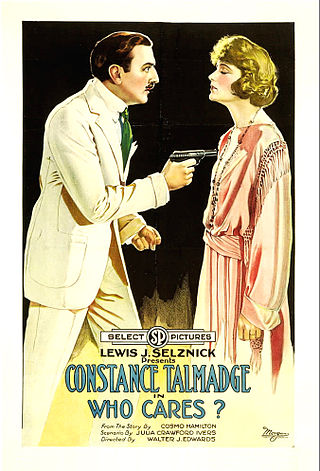
Who Cares? is a lost 1919 American silent film comedy starring Constance Talmadge and Harrison Ford. The director was Walter Edwards who usually worked with Marguerite Clark. Julia Crawford Ivers wrote the scenario based on the 1919 Cosmo Hamilton novel, and her son James Van Trees was the film's cinematographer.

The Love Gambler is a 1922 American silent Western film directed by Joseph Franz and written by Jules Furthman. The film stars John Gilbert, Carmel Myers, Bruce Gordon, C.E. Anderson, W. E. Lawrence and James Gordon. The film was released on November 12, 1922, by Fox Film Corporation.

The Dream Lady is a 1918 American silent drama film directed by Elsie Jane Wilson and starring Carmel Myers. It was produced by Bluebird Photoplays and distributed by Universal Film Manufacturing Company.

The Love Pirate is a 1923 American silent drama film directed by Richard Thomas and starring Melbourne MacDowell, Carmel Myers and Kathryn McGuire.

The Red Sword is a 1929 American silent adventure film directed by Robert G. Vignola and starring William Collier Jr., Marian Nixon and Carmel Myers. The film was produced and distributed by FBO Pictures, shortly before it was taken over by RKO Pictures. It was released in Britain by Ideal Films under the alternative title Three Days to Live.





















